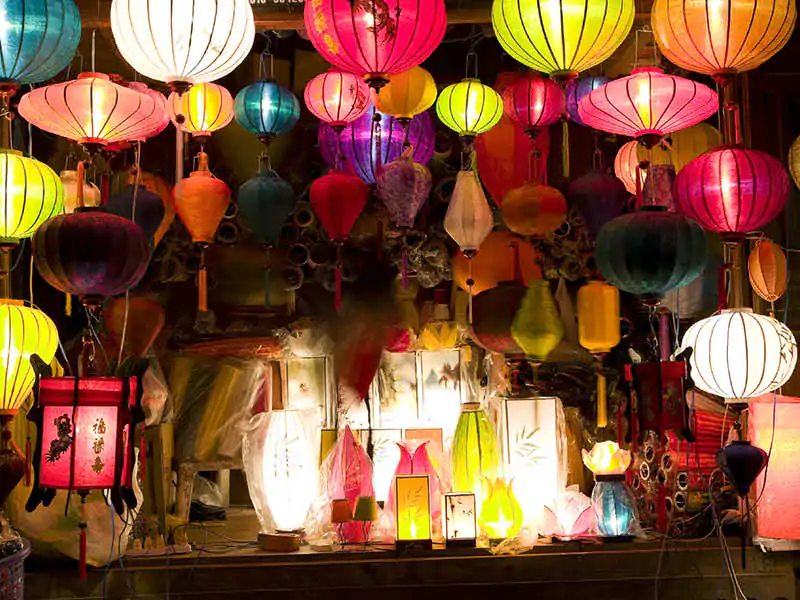1. Light a lantern in Hoi An
Every Tết (Vietnamese New Year), Hoi An is transformed into a kaleidoscope of colour and light for its Lantern Festival. The celebration lasts for seven days, with the road from Hoi An Bridge to the Hoai River Square adorned with thousands of colourful lanterns. Over 50 workshops take part in the event, each trying to create the prettiest lantern. The colours are bright and the designs are strictly traditional.
The heart of the festivities is in the old town, between the Japanese Covered Bridge and the Cau An Hoi Bridge. It’s crowded, chaotic and festive, with spontaneous singing and food stalls at every turn. It is as much a celebration for locals as it is for visitors.
The most breathtaking sight is thousands of lanterns floating on the river; hire a sampan boat to get a closer look. For a small sum, you can buy a lantern and set it afloat too.
Don’t worry if you can’t make it to Hoi An for New Year: smaller lantern festivals are held every full moon. In 2019, Vietnamese New Year falls on 5 February.

2. Visit Halong Bay’s equally spectacular neighbour
With 1,600 limestone towers rising from its turquoise waters, Halong Bay is rightly considered one of Vietnam’s most beautiful spots. As a result, it’s on every visitor’s list – and hundreds of boats offer cruise trips every day. The bay is huge, but it can still feel crowded.
Bai Tu Long Bay, just a few miles away, offers the same jaw-dropping scenery but sees only a fraction of the visitors. Here you can explore uncrowded caves and tiny beaches, and feast on super-fresh succulent seafood.
Boat trips to Bai Tu Long Bay leave from the crowded dock at Halong City, just like the ones to Halong Bay. But you’ll head off in the opposite direction, to where the islands are a little less taller and a little more spread out – but, according to locals, are just like what those in Halong Bay used to be like.

3. Cruise the Mekong Delta
After travelling over 4,000 kilometres from the Tibetan Himalaya, the Mekong hits Vietnam and slows down to a more languid pace. With islands, rice paddies, stilted villages and a way of life that hasn’t changed for centuries, it’s as if the river wants to take it easy and soak up the view.
Hitch a ride with a cargo boat and you can do exactly that too. Simply find a shady spot to hitch your hammock and gaze at faraway riverbanks as your boat, weighed down with fruit and rice sacks, ploughs the treacly brown flow.
Or, take one of the many commercial cruises that ply parts of the river. The cruise from Cai Be to Can Tho is a great way to experience a night on the river. As you travel southwards along the Mang Thit River linking the Tien Giang and Bassac systems, the channel becomes so narrow that you can peer into the riverbank’s rickety stilted houses.

4. Drop into the world’s largest cave
Quang Binh province is a wild region of barely penetrable jungle in Vietnam’s skinny middle, close to the border with Laos. The area is riddled with hundreds of deep caves, including one of the largest in the world – Hang Son Doong. It contains a cavern so tall that a skyscraper could fit inside it.
The small town of Phong Nha is the epicentre for the area’s caving adventures. Here you can hire both guides and the gear you’ll need to descend into the caves.
If going underground doesn’t appeal, the area is also famous for trekking. The surrounding jungle is peppered with stunning waterfalls and an active (and noisy) population of monkeys and flying foxes.
5. Enjoy a cup of ‘weasel coffee’
Buon Ma Thuot is the regional capital of the central highlands of Vietnam, a gorgeous area of thundering waterfalls and the traditional villages of the local Ede people. Look out for stilted structures reached by a ladder and marked by carved breasts. In this fiercely matriarchal area, they can only be used by the women of the house.
Buon Ma Thuot is also the heart of Vietnam’s thriving coffee industry. The Trung Nguyen coffee company is the big player here and there’s not a corner of paddy field or industrial zone in the area that doesn’t bear their logo. The upside is that the coffee here is excellent – especially the ‘weasel’ variety.
Weasel coffee is the Vietnamese variation of Indonesia’s Kopi Luwak, produced with the help of small weasel-like creatures called civets. The civet eats the coffee berries, passes them quickly, and imbues them with a uniquely bitter taste.
Aficionados claim it is the best coffee in the world and are willing to pay big prices for it. You can enjoy it at the source for a fraction of the cost.
 Editor team
Editor team November 17, 2018
November 17, 2018 Vietnam
Vietnam
 552
552 YOU MAY ALSO LIKE
YOU MAY ALSO LIKE
 read more
read more
